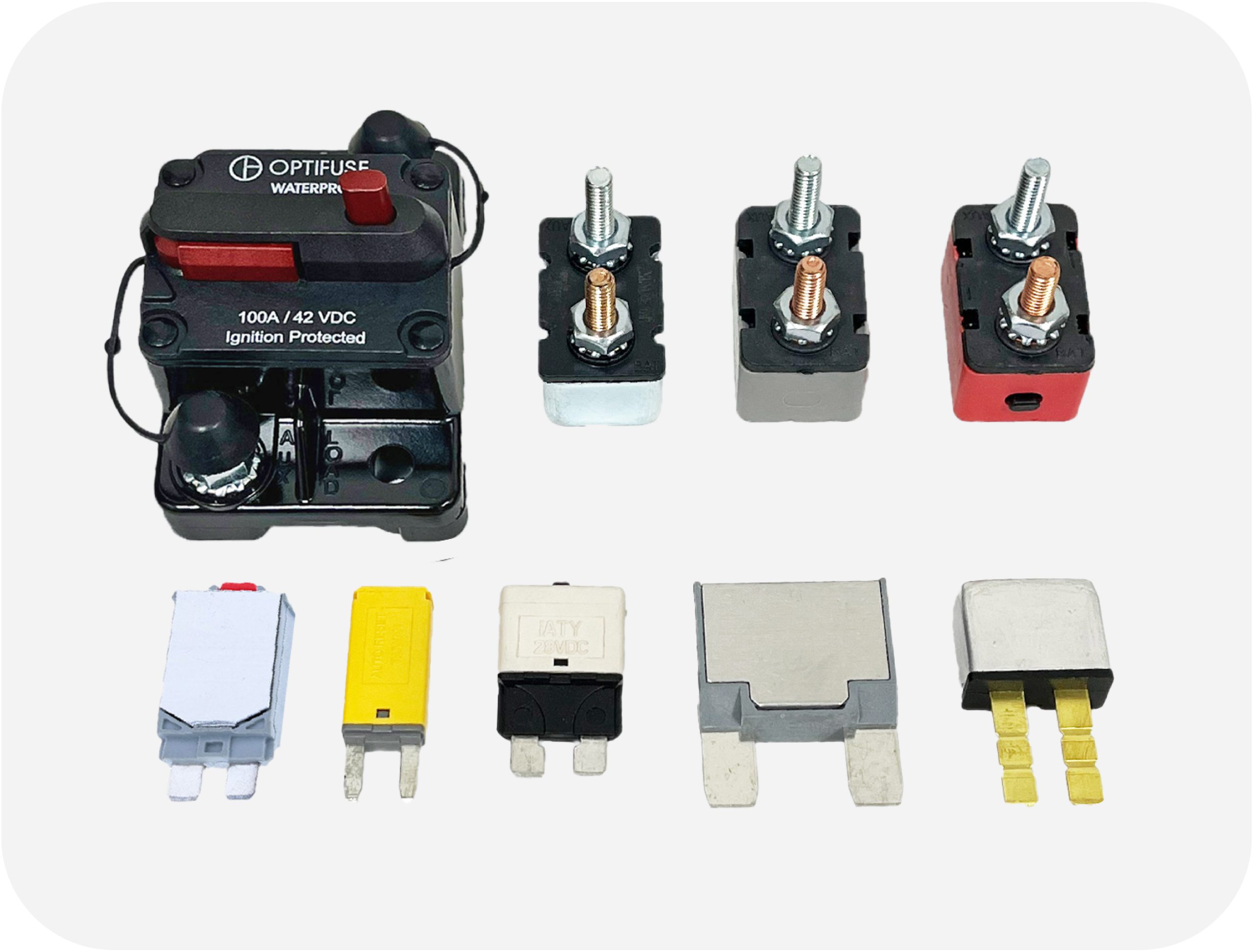Circuit Breakers Reset Types

Automotive low voltage circuit breakers are available in three different reset types, as designated by SAE in its J553 specification. Each type performs the same basic function, which is to clear a circuit in the event of an overcurrent, usually by utilizing the heat from an overcurrent to trigger a heat-sensitive mechanism that cuts off current flow.
The reset types available for automotive circuit breakers are type I (automatic reset), type II (modified reset) and type III (manual reset).
Type I (Automatic) Reset
This type of circuit breaker uses a bimetal strip that heats up when hit with energy from an overcurrent, causing it to flex and open to clear the circuit. After it disconnects the circuit, the bimetal strip inside eventually cools down, unflexes and reconnects the circuit.
You’ll find this automatic reset functionality in several OptiFuse series, including the ACBP-N, ACBP4-PL and ACB2-PL Series. These options are ideal for circuits that aren’t easily accessed for manual resets and where automatic recovery is beneficial.
If the original fault is not fixed before the circuit breaker resets, the bimetal strip will repeatedly reheat and continuously initiate the process of connecting and disconnecting the circuit.
This condition, in which the breaker continues to open and close indefinitely, is sometimes called a “bounce effect”. Eventually, the “bounce” could cause a premature failure in the circuit breaker, or even the circuit itself.
Type II (Modified) Reset
The basic construction of type II circuit breakers is mostly the same as type I breakers. One key difference is that in type II breakers, a heating element is placed on or around the bimetal strip.
That heating element is off (cold) when the circuit breaker is closed (in its normal condition). But when the circuit breaker opens, the heating element turns on, enhancing the heat from an overcurrent that is already hitting the breaker’s bimetal strip.
This ensures the strip never gets a chance to cool off and reset the breaker. That action keeps the breaker from “bouncing” off and on.
OptiFuse’s MOCBP4-PM, MOCB-12-H and MOCB2-PCL Series circuit breakers offer this reset method, making them ideal for situations where automatic cycling could be hazardous or damaging to equipment.
The only way to reset the type II circuit breaker is to turn off power to the entire system the breaker is protecting. In auto applications, this generally means turning off the ignition switch for a few moments.
Type III (Manual) Reset
Here too, the basic structure is mostly the same as that of type I and type II breakers. The notable difference is that in type III breakers there is a mechanical latch that activates when the breaker opens due to an overcurrent.
This latch must be reset by hand before the circuit breaker can reset itself. This means that because type III circuit breakers must be manually reset, they must be installed in accessible places.
How to Choose a Reset Type
Before deciding which reset type of circuit breaker is right for you, consider factors relating to the application in which you plan to use the breaker. You can also read our how to reset circuit breakers article to understand reset methods based on breaker types.
Devices work well in relatively low voltage applications, such as headlamps and windshield wipers. This reset type is great for applications in which overload situations are rare and for which the circuit breaker must be installed in a hard-to-reach space in the vehicle, making manual resetting unfeasible.
Circuit breakers are best for applications that only need circuit protection when the vehicle’s engine is turned on, because these breakers will reset when the engine is turned off or when an overload situation is removed.
Breakers generally offer higher current protection and work well to draw attention to underlying problems in a circuit. That’s because any equipment the breaker protects won’t start up again until the breaker is reset by hand. This makes breakers with this reset type ideal for applications in which the device is installed in an easily accessible place in the vehicle.
For comprehensive guidance on selecting the appropriate parameters for overcurrent protection, see our Circuit Protective Device Selection Guide for complete context.
Samuel Kenny, Product Manager at OptiFuse, leads the development of advanced circuit protection products for automotive, marine, and industrial sectors. He designs custom solutions and shares expert fuse selection tips on the OptiFuse Blog.